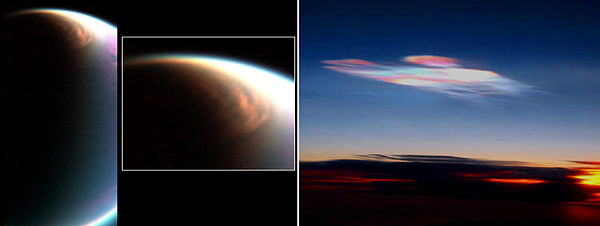Extraterrestrial atmosphere
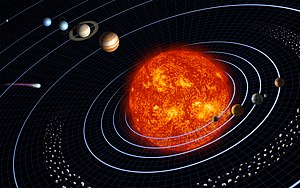
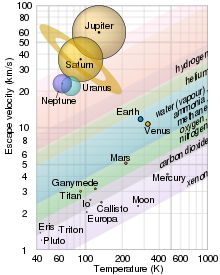
The study of extraterrestrial atmospheres is an active field of research,
In September 2022, astronomers were reported to have formed a new group, called "
Planets
Inner planets
Mercury
Due to its small size (and thus its small gravity), Mercury has no substantial atmosphere. Its extremely thin atmosphere mostly consists of a small amount of helium and traces of sodium, potassium, and oxygen. These gases derive from the solar wind, radioactive decay, meteor impacts, and breakdown of Mercury's crust.[4][5] Mercury's atmosphere is not stable and is constantly being refreshed because of its atoms escaping into space as a result of the planet's heat.
Venus

Venus' atmosphere is mostly composed of
The troposphere begins at the surface and extends up to an altitude of 65 kilometres (an altitude at which the mesosphere has already been reached on Earth). At the top of the troposphere, temperature and pressure reach Earth-like levels. Winds at the surface are a few metres per second, reaching 70 m/s or more in the upper troposphere. The stratosphere and mesosphere extend from 65 km to 95 km in height. The thermosphere and exosphere begin at around 95 kilometres, eventually reaching the limit of the atmosphere at about 220 to 250 km.
The air pressure at Venus' surface is about 92 times that of the Earth. The enormous amount of CO2 in the atmosphere creates a strong greenhouse effect, raising the surface temperature to around 470 °C, hotter than that of any other planet in the Solar System.
Mars
The Martian atmosphere is very thin and composed mainly of carbon dioxide, with some nitrogen and argon. The average surface pressure on Mars is 0.6-0.9 kPa, compared to about 101 kPa for Earth. This results in a much lower atmospheric thermal inertia, and as a consequence Mars is subject to strong thermal tides that can change total atmospheric pressure by up to 10%. The thin atmosphere also increases the variability of the planet's temperature. Martian surface temperatures vary from lows of approximately −140 °C (−220 °F) during the polar winters to highs of up to 20 °C (70 °F) in summers.

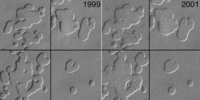
Between the
Colin Wilson has proposed that the observed variations are caused by irregularities in the orbit of Mars.[14] William Feldman speculates the warming could be because Mars might be coming out of an ice age.[15] Other scientists state the warming may be a result of albedo changes from dust storms.[16][17] The study predicts the planet could continue to warm, as a result of positive feedback.[17]
On June 7, 2018, NASA announced that the Curiosity rover detected a cyclical seasonal variation in atmospheric methane, as well as the presence of kerogen and other complex organic compounds.[18][19][20][21][22][23][24][25]
Gas giants
The four outer planets of the Solar System are all
Jupiter
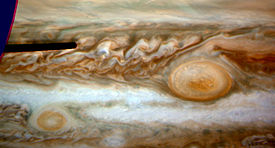
Jupiter's upper atmosphere is composed of about 75% hydrogen and 24% helium by mass, with the remaining 1% consisting of other elements. The interior contains denser materials such that the distribution is roughly 71% hydrogen, 24% helium and 5% other elements by mass. The atmosphere contains trace amounts of methane, water vapor, ammonia, and silicon-based compounds. There are also traces of carbon, ethane, hydrogen sulfide, neon, oxygen, phosphine, and sulfur. The outermost layer of the atmosphere contains crystals of frozen ammonia, possibly underlaid by a thin layer of water.
Jupiter is covered with a cloud layer about 50 km deep. The clouds are composed of
Observations of the
Saturn
The outer atmosphere of Saturn consists of about 93.2% hydrogen and 6.7% helium. Trace amounts of ammonia, acetylene, ethane, phosphine, and methane have also been detected. As with Jupiter, the upper clouds on Saturn are composed of ammonia crystals, while the lower level clouds appear to be composed of either ammonium hydrosulfide (NH4SH) or water.
The Saturnian atmosphere is in several ways similar to that of Jupiter. It exhibits a banded pattern similar to Jupiter's, and occasionally exhibits long-lived ovals caused by storms. A storm formation analogous to Jupiter's Great Red Spot, the Great White Spot, is a short-lived phenomenon that forms with a roughly 30-year periodicity. It was last observed in 1990. However, the storms and the band pattern are less visible and active than those of Jupiter, due to the overlying ammonia hazes in Saturn's troposphere.
Saturn's atmosphere has several unusual features. Its winds are among the Solar System's fastest, with
Uranus
The atmosphere of Uranus is composed primarily of gas and various ices. It is about 83% hydrogen, 15% helium, 2% methane and traces of acetylene. Like Jupiter and Saturn, Uranus has a banded cloud layer, although this is not readily visible without enhancement of visual images of the planet. Unlike the larger gas giants, the low temperatures in the upper Uranian cloud layer, down to 50 K, causes cloud formation from methane rather than ammonia.
Less storm activity has been observed in the Uranian atmosphere than in those of Jupiter or Saturn, due to the overlying methane and acetylene hazes in its atmosphere making the planet look like a bland, light blue globe.[citation needed] Images taken in 1997 with the Hubble Space Telescope showed storm activity in that part of the atmosphere emerging from the 25-year-long Uranian winter. The general lack of storm activity may be related to the lack of an internal energy generation mechanism for Uranus, a feature unique among the gas giants.[30]
Neptune
The atmosphere of Neptune is similar to that of Uranus. It is about 80% hydrogen, 19% helium, and 1.5% methane. However the weather activity on Neptune is much more active, and its atmosphere is much bluer than that of Uranus. The upper levels of the atmosphere reach temperatures of about 55 K, giving rise to methane clouds in its troposphere, which gives the planet its ultramarine color. Temperatures rise steadily deeper inside the atmosphere.
Neptune has extremely dynamic weather systems, including the highest wind speeds in the Solar System, thought to be powered by the flow of internal heat. Typical winds in the banded equatorial region can possess speeds of around 350 m/s (comparable to the speed of sound at room temperature on Earth[31] viz. 343.6 m/s) while storm systems can have winds reaching up to around 900 m/s, in Neptune's atmosphere. Several large storm systems have been identified, including the Great Dark Spot, a cyclonic storm system the size of Eurasia, the Scooter, a white cloud group further south than the Great Dark Spot, and the Wizard's eye/Dark Spot 2, a southern cyclonic storm.
Other bodies in the Solar System
Natural satellites
Ten of the many natural satellites in the Solar System are known to have atmospheres:
Moon
Titan
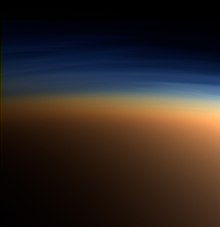
Titan's atmosphere supports an opaque cloud layer that obscures Titan's surface features at visible wavelengths. The haze that can be seen in the adjacent picture contributes to the moon's anti-greenhouse effect and lowers the temperature by reflecting sunlight away from the satellite. The thick atmosphere blocks most visible wavelength light from the Sun and other sources from reaching Titan's surface.
Triton
Triton, Neptune's largest moon, has a tenuous nitrogen atmosphere with small amounts of methane. Tritonian atmospheric pressure is about 1Pa. The surface temperature is at least 35.6 K, with the nitrogen atmosphere in equilibrium with nitrogen ice on Triton's surface.
Triton has increased in absolute temperature by 5% since 1989 to 1998.[34][35] A similar rise of temperature on Earth would be equal to about 11 °C (20 °F) increase in temperature in nine years. "At least since 1989, Triton has been undergoing a period of global warming. Percentage-wise, it's a very large increase," said James L. Elliot, who published the report.[34]
Triton is approaching an unusually warm summer season that only happens once every few hundred years. Elliot and his colleagues believe that Triton's warming trend could be driven by seasonal changes in the absorption of solar energy by its polar ice caps. One suggestion for this warming is that it is a result of frost patterns changing on its surface. Another is that ice albedo has changed, allowing for more heat from the Sun to be absorbed.[36] Bonnie J. Buratti et al. argue the changes in temperature are a result of deposition of dark, red material from geological processes on the moon, such as massive venting. Because Triton's Bond albedo is among the highest within the Solar System, it is sensitive to small variations in spectral albedo.[37]
Pluto
Near-sunset view includes several layers of atmospheric haze
Pluto has an extremely thin atmosphere that consists of nitrogen, methane, and carbon monoxide, derived from the ices on its surface.[38] Two models[39][40] show that the atmosphere does not completely freeze and collapse when Pluto moves further from the Sun on its extremely elliptical orbit. However, some other models do show this. Pluto needs 248 years for one complete orbit, and has been observed for less than one third of that time. It has an average distance of 39 AU from the Sun, hence in-depth data from Pluto is sparse and difficult to gather. Temperature is inferred indirectly for Pluto; when it passes in front of a star, observers note how fast the light drops off. From this, they deduce the density of the atmosphere, and that is used as an indicator of temperature.

One such occultation event happened in 1988. Observations of a second occultation on August 20, 2002 suggest that Pluto's atmospheric pressure has tripled, indicating a warming of about 2 °C (3.6 °F),[41][42] as predicted by Hansen and Paige.[43] The warming is "likely not connected with that of the Earth," says Jay Pasachoff.[44] One astronomer has speculated the warming may be a result of eruptive activity, but it is more likely Pluto's temperature is heavily influenced by its elliptical orbit. It was closest to the Sun in 1989 (perihelion) and has slowly receded since. If it has any thermal inertia, it is expected to warm for a while after it passes perihelion.[45] "This warming trend on Pluto could easily last for another 13 years," says David J. Tholen.[41] It has also been suggested that a darkening of surface ice may also be the cause, but additional data and modeling is needed. Frost distribution on the surface of Pluto is significantly affected by the dwarf planet's high obliquity.[46]
Brown dwarfs
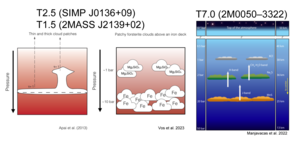
Brown dwarfs have an atmosphere that produces a spectrum from late M-type, over L-type, T-type and finally arriving at Y-dwarf with decreasing temperature. The atmosphere is hydrogen rich and a brown dwarf is 70% hydrogen by mass.[47] Several chemical compounds are present in the atmosphere of brown dwarfs and their importance in shaping the spectrum changes with temperature. Methane and water vapor for example becomes more prominent for colder brown dwarfs.[48]
The physical properties can influence the atmosphere significantly. A low surface gravity of low-mass brown dwarfs or planetary-mass objects can bring the atmosphere in a chemical disequilibrium.[49] Metallicity can influence the amount of methane in the atmosphere and in the extreme case of WISEA 1810−1010 the methane feature is undetectable.
Several models for clouds in the atmosphere of brown dwarfs exist. Near the L/T transition these clouds consists of iron with varying thickness, or of a patchy silicate cloud layer above a thick iron cloud layer.[50] Late T-dwarfs to early Y-dwarfs on the other hand have clouds made from chromium and potassium chloride, as well as several sulfides. At the lowest temperature of some Y-dwarfs water clouds and possibly ammonium dihydrogen phosphate clouds might exist.[51]
Free-floating brown dwarfs rotate faster than Jupiter and studies have inferred the presence of zonal winds. The brown dwarf 2MASS J1047+21 has a rotation period of 1.77 ± 0.04 hours and it has strong winds with speeds of 650±310 m/s proceeding eastwards.[52]
Exoplanets
Several planets outside the Solar System (
The first observation of an extrasolar planetary atmosphere was made in 2001.[53] Sodium in the atmosphere of the planet HD 209458 b was detected during a set of four transits of the planet across its star. Later observations with the Hubble Space Telescope showed an enormous ellipsoidal envelope of hydrogen, carbon and oxygen around the planet. This envelope reaches temperatures of 10,000 K. The planet is estimated to be losing (1–5)×108 kg of hydrogen per second. This type of atmosphere loss may be common to all planets orbiting Sun-like stars closer than around 0.1 AU.[54] In addition to hydrogen, carbon, and oxygen, HD 209458 b is thought to have water vapor in its atmosphere.[55][56][57] Sodium and water vapour has also been observed in the atmosphere of HD 189733 b,[58][59] another hot gas giant planet.
In October 2013, the detection of
In May 2017, glints of light from
The technology used to determine this may be useful in studying the atmospheres of distant worlds, including those of exoplanets.Atmospheric composition
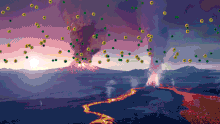
In 2001, sodium was detected in the atmosphere of HD 209458 b.[53]
In 2008, water, carbon monoxide, carbon dioxide[68] and methane[69] were detected in the atmosphere of HD 189733 b.
In 2013, water was detected in the atmospheres of HD 209458 b, XO-1b, WASP-12b, WASP-17b, and WASP-19b.[70][71][72]
In July 2014, NASA announced finding very dry
In September 2014, NASA reported that HAT-P-11b is the first Neptune-sized exoplanet known to have a relatively cloud-free atmosphere and, as well, the first time molecules of any kind have been found, specifically water vapor, on such a relatively small exoplanet.[74]
The presence of molecular oxygen (O
2) may be detectable by ground-based telescopes,[75] and it can be produced by geophysical processes, as well as a byproduct of photosynthesis by life forms, so although encouraging, O
2 is not a reliable biosignature.[76][77][78] In fact, planets with high concentration of O
2 in their atmosphere may be uninhabitable.[78] Abiogenesis in the presence of massive amounts of atmospheric oxygen could be difficult because early organisms relied on the free energy available in redox reactions involving a variety of hydrogen compounds; on an O
2-rich planet, organisms would have to compete with the oxygen for this free energy.[78]
In June 2015, NASA reported that
In February 2016, it was announced that NASA's Hubble Space Telescope had detected hydrogen and helium (and suggestions of hydrogen cyanide), but no water vapor, in the atmosphere of 55 Cancri e, the first time the atmosphere of a super-Earth exoplanet was analyzed successfully.[82]
In September 2019, two independent research studies concluded, from Hubble Space Telescope data, that there were significant amounts of water in the atmosphere of exoplanet K2-18b, the first such discovery for a planet within a star's habitable zone.[83][84][85]
On 24 Aug 2022, NASA published the discovery by the James Webb Space Telescope of carbon dioxide in the atmosphere of WASP-39b.[86][87]
Missing Methane Problem
Carbon monoxide should be replaced by methane as the dominant carbon-bearing molecule in the atmosphere of exoplanets at temperatures below 1000 K. While methane is detected in solar system objects, young directly imaged exoplanets and in free-floating brown dwarfs (T/Y-dwarfs), it is rarely detected in transiting exoplanets. This observation was dubbed the Missing Methane Problem. Some studies tried to explain this with a depletion of methane. The most solid detection of methane is in the atmosphere of the warm Jupiter (825 K) WASP-80b, which was detected with NIRCam. This detection is in agreement with models that do not require a strong methane depletion. This detection suggested that other instruments did not have the wavelength coverage or precision needed to detect methane.[88] Non-detection of methane in HD 209458b on the other hand showed that the missing methane problem cannot be resolved for all exoplanets with JWST and an explanation for the missing methane is required. Explanations often involve a high metallicity and a low carbon-to-oxygen ratio.[88][89]
A similar problem exists for the detection of ammonia.[90] Methane and ammonia is detected in free-floating Y-dwarfs (Teff<400 K), such as WISE 0359−5401. Transiting exoplanets on the other hand do rarely show ammonia. For example the ~300 K exoplanets K2-18b showed a depletion of methane and ammonia[91] and more recent observations with NIRISS and NIRSpec was able to resolve the methane problem for K2-18b. The observations showed strong absorption due to methane, but was not able to detect any ammonia in K2-18b.[92] The research team explained this missing ammonia with an ocean that absorbs certain gases. Other researchers are more cautious about this ocean claim.[93] One problem is that ammonia and methane absorption overlap in the near-infrared. Ammonia absorption could be mistaken as methane and mid-infrared detections of ammonia are much clearer, such as in WISE 0359−5401 with MIRI.
Another problem exists for phosphine (PH3) which is a strong absorber in Jupiter, but does not appear in similar cold free-floating T- and Y-dwarfs, such as WISE 0855−0714, WISE 0359−5401, WISE 1828+2650 and 2MASS 0415−0935. One explanation is that the behaviour of phosphorus in the atmosphere of brown dwarfs to giant exoplanets is not well understood.[94]
Atmospheric circulation
The atmospheric circulation of planets that rotate more slowly or have a thicker atmosphere allows more heat to flow to the poles which reduces the temperature differences between the poles and the equator.[95]
Winds
Winds of over 2 km/s—which is seven times the
Clouds
The composition of clouds in gas giants depend on temperature. A cloud layer does "sink" with decreasing temperature. This way one exoplanet might have a cloud layer at a higher pressure (lower altitude) compared to a warmer exoplanet.[50][51] High altitude clouds often block light coming from deeper layers of the atmosphere, including chemical absorption features. Weaker than normal absorption features is the main method to detect the presence of clouds via transmission spectroscopy.[98] In some cases the absorption from the clouds can be directly observed, such as quatz-clouds on WASP-17b with JWST.[99] One way to predict the appearance of a gas giant is the Sudarsky's gas giant classification. But this classification scheme is over two decades old and more recent models[51] sometimes predict thin clouds for class III and class IV. This classification also does not consider ultra-hot Jupiters, which do have nightside clouds.[100] Relative cloud-free atmospheres also exist.[101]
Similar to brown dwarfs the composition at hotter temperature (class V or >900 K)[51] is a thick iron cloud deck with silicate clouds (quartz, corundum, fosterite and/or enstatite) on top. This top layer can be patchy and cover 70-90% of the planet.[50][102] At lower temperatures (class III-IV or 400-1,300 K) the iron and silicate clouds sink deep into the atmosphere and thin clouds made of chromium, potassium chloride and especially sulfides (manganese sulfide, sodium sulfide and zink sulfide) become more important. At low temperatures (class II <400 K) water clouds and possibly ammonium dihydrogen phosphate clouds might exist. But lower layers of clouds of sulfides and potassium chloride should exist at this temperature.[51] Jupiter and Saturn-like atmospheres (class I or <150 K) are dominated by ammonia clouds, but lower layers of water clouds might exist.[103]
A newer type of exoplanets, called ultra-hot Jupiters have a temperature above 2,000 K and have a cloud-free dayside[100] with molecules often dissociated into atoms or ions. A wide variety of atomic lines were detected in the transmission spectra of the ultra-hot Jupiters.[104][105][106] The nightside can be up to 2,500 K colder than the dayside and in WASP-18b this temperature drop causes clouds to form at the terminator. At the equator of the terminator, which forms clouds on WASP-18b (in the west seen from the dayside) the cloud top is made of thin layers dominated by titanium dioxide, corundum (aluminium oxide), perovskite (calcium titanate) and iron. The majority of the vertical portion of the cloud is made up of clouds of enstatite, fosterite, periclase (magnesium oxide), quartz, iron and inclusion of other material. The cloud bottom changes from quartz dominated, to iron, then corundum and then perovskite dominated. These bottom layers have large particle sizes of about 60 μm. At other positions of the terminator these clouds change their composition and particle size.[100] The cloud-free dayside and the cloudy terminator/nightside would make these ultra-hot Jupiters look similar to an eyeball planet.
In October 2013, the detection of
Precipitation
Precipitation in the form of liquid (rain) or solid (snow) varies in composition depending on atmospheric temperature, pressure, composition, and altitude. Hot atmospheres could have iron rain,[107] molten-glass rain,[108] and rain made from rocky minerals such as enstatite, corundum, spinel, and wollastonite.[109] Deep in the atmospheres of gas giants, it could rain diamonds[110] and helium containing dissolved neon.[111]
Abiotic oxygen
There are geological and atmospheric processes that produce free oxygen, so the detection of oxygen is not necessarily an indication of life.[112]
The processes of life result in a mixture of chemicals that are not in
Life
Methane
Detection of methane in astronomical bodies is of interest to science and technology, as it may be evidence of extraterrestrial life (biosignature),[116][117] it may help provide organic ingredients for life to form,[116][118][119] and also, methane could be used as a fuel or rocket propellant for future robotic and crewed missions in the Solar System.[120][121]
- Mercury – the tenuous atmosphere contains trace amounts of methane.[122]
- Mass Spectrometer[123]
- Moon – traces are outgassed from the surface[124]

- ExoMars Trace Gas Orbiter will perform measurements of methane starting in April 2018, as well as its decomposition products such as formaldehyde and methanol.
- Jupiter – the atmosphere contains 3000 ± 1000 ppm methane[137]
- Saturn – the atmosphere contains 4500 ± 2000 ppm methane[138]
- Enceladus – the atmosphere contains 1.7% methane[139]
- Iapetus[citation needed]
- Titan – the atmosphere contains 1.6% methane and thousands of methane lakes have been detected on the surface.[140] In the upper atmosphere, methane is converted into more complex molecules including acetylene, a process that also produces molecular hydrogen. There is evidence that acetylene and hydrogen are recycled into methane near the surface. This suggests the presence of either an exotic catalyst or an unknown form of methanogenic life.[141] Methane showers, probably prompted by changing seasons, have also been observed.[142] On October 24, 2014, methane was found in polar clouds on Titan.[143][144]
- Uranus – the atmosphere contains 2.3% methane[145]
- Ariel – methane is believed to be a constituent of Ariel's surface ice
- Miranda[citation needed]
- Oberon – about 20% of Oberon's surface ice is composed of methane-related carbon/nitrogen compounds
- Titania – about 20% of Titania's surface ice is composed of methane-related organic compounds[citation needed]
- Umbriel – methane is a constituent of Umbriel's surface ice
- Neptune – the atmosphere contains 1.5 ± 0.5% methane[146]
- Eris – infrared light from the object revealed the presence of methane ice[152]
- Halley's Comet
- Comet Hyakutake – terrestrial observations found ethane and methane in the comet[153]
- exoplanet atmospheres could add hydrocarbon gases such as methane, making the exoplanets look as though they are inhabited by life, even if they are not.[155]
- Interstellar clouds[156]
- The atmospheres of M-type stars.[157]
See also
References
- ^ "Department of Atmospheric Science, University of Washington". Retrieved 2007-05-24.
- ^ "NASA GISS: Research in Planetary Atmospheres". Archived from the original on 2007-05-16. Retrieved 2007-05-24.
- ^ Gertner, Jon (15 September 2022). "The Search for Intelligent Life Is About to Get a Lot More Interesting - There are an estimated 100 billion galaxies in the universe, home to an unimaginable abundance of planets. And now there are new ways to spot signs of life on them". The New York Times. Retrieved 15 September 2022.
- ^ "Thin Atmosphere of Mercury, Formation and Composition - Windows to the Universe". www.windows.ucar.edu. Archived from the original on 2010-03-27. Retrieved 2007-05-25.
- ^ "ESA Science & Technology: Mercury Atmosphere". esa.int. 21 July 2012. Archived from the original on 21 July 2012.
- ^ Picone, J.; Lean, J. (2005). "Global Change in the Thermosphere: Compelling Evidence of a Secular Decrease in Density". 2005 NRL Review: 225–227.
- Bibcode:2005ESASP.587..243L.
- .
- S2CID 140643009.
- .
- ^ Reddy, Francis (2005-09-23). "MGS sees changing face of Mars". Astronomy. Retrieved 2007-02-22.
- ^ "Orbiter's Long Life Helps Scientists Track Changes on Mars". NASA. 2005-09-20. Archived from the original on April 30, 2007. Retrieved 2007-05-09.
- S2CID 7433260.
- ^ Ravilious, Kate (2007-03-28). "Mars Melt Hints at Solar, Not Human, Cause for Warming, Scientist Says". National Geographic Society. Archived from the original on March 2, 2007. Retrieved 2007-05-09.
- ^ "Mars Emerging from Ice Age, Data Suggest". Space.com. 2003-12-08. Retrieved 2007-05-10.
- S2CID 4411643. Archived from the original(PDF) on 2007-07-08. Retrieved 2007-05-09.
- ^ a b Ravilious, Kate (2007-04-04). "Mars Warming Due to Dust Storms, Study Finds". National Geographic Society. Archived from the original on April 9, 2007. Retrieved 2007-05-19.
- ^ Brown, Dwayne; Wendel, JoAnna; Steigerwald, Bill; Jones, Nancy; Good, Andrew (June 7, 2018). "Release 18-050 - NASA Finds Ancient Organic Material, Mysterious Methane on Mars". NASA. Retrieved June 7, 2018.
- ^ NASA (June 7, 2018). "Ancient Organics Discovered on Mars - video (03:17)". NASA. Archived from the original on 2021-12-21. Retrieved June 7, 2018.
- ^ Wall, Mike (June 7, 2018). "Curiosity Rover Finds Ancient 'Building Blocks for Life' on Mars". Space.com. Retrieved June 7, 2018.
- ^ Chang, Kenneth (June 7, 2018). "Life on Mars? Rover's Latest Discovery Puts It 'On the Table' - The identification of organic molecules in rocks on the red planet does not necessarily point to life there, past or present, but does indicate that some of the building blocks were present". The New York Times. Retrieved June 8, 2018.
- S2CID 115442477. Retrieved June 7, 2018.
- S2CID 195666358.
- PMID 29880682.
- PMID 29880683.
- Bibcode:2006APS..DFD.FG005M.
- ^ Goudarzi, Sara (2006-05-04). "New Storm on Jupiter Hints at Climate Change". Space.com. Retrieved 2007-05-09.
- S2CID 4412876. Archived from the original(PDF) on 2007-04-16. Retrieved 2007-05-09.
- ^ Yang, Sarah (2004-04-21). "Researcher predicts global climate change on Jupiter as giant planet's spots disappear". University of California, Berkeley. Retrieved 2007-05-09.
- ^ "Uranus' Atmosphere". Retrieved 2007-05-23.
- ^ "Speed of sound calculation".
- ^ "AGU - American Geophysical Union". AGU. Archived from the original on 2012-11-02. Retrieved 2007-05-10.
- ISBN 978-0521844123.
- ^ a b "MIT researcher finds evidence of global warming on Neptune's largest moon". Massachusetts Institute of Technology. 1998-06-24. Retrieved 2007-05-10.
- S2CID 40865426. Archived from the originalon 2011-05-20. Retrieved 2007-05-10.
- ^ "Global Warming Detected on Triton". Scienceagogo.com. 1998-05-28. Retrieved 2007-05-10.
- PMID 9930696.
- ^ Ken Croswell (1992). "Nitrogen in Pluto's Atmosphere". Retrieved 2007-04-27.
- .
- hdl:10261/167246.
- ^ a b Britt, Roy (2002-10-09). "Global Warming on Pluto Puzzles Scientists". Space.com. Retrieved 2007-05-09.
- S2CID 10512970. Archived from the original(PDF) on 2007-04-17. Retrieved 2007-05-10.
- ^ Staff (April 2014). "Postcards from Pluto". Tumblr. Retrieved March 1, 2015.
- ^ "Pluto is undergoing global warming, researchers find". Massachusetts Institute of Technology. 2002-10-09. Retrieved 2007-05-09.
- ^ Lakdawalla, E. (April 17, 2013). "Pluto's atmosphere does not collapse". Retrieved November 11, 2014.
- .
- ^ "Brown Dwarf - an overview | ScienceDirect Topics". www.sciencedirect.com. Retrieved 2023-10-16.
The brown dwarfs are distinguished from white dwarfs first by their very cool surface temperatures and second by the fact that their internal composition is practically unchanged from the time of formation; that is, it is about 71% hydrogen by mass.
- ISSN 0004-637X.
See Figure 3 to 7
- ISSN 0004-637X.
- ^ ISSN 0004-637X.
- ^ S2CID 118398946.
- S2CID 264645727.
- ^ S2CID 14487268.
- arXiv:astro-ph/0312384.
- ^ Water Found in Extrasolar Planet's Atmosphere - Space.com
- ^ Signs of water seen on planet outside solar system, by Will Dunham, Reuters, Tue April 10, 2007 8:44PM EDT
- ^ Water Identified in Extrasolar Planet Atmosphere Archived 2007-05-16 at the Wayback Machine, Lowell Observatory press release, April 10, 2007
- S2CID 55263138.
- ^ "Press Release: NASA's Spitzer Finds Water Vapor on Hot, Alien Planet". caltech.edu. Archived from the original on 2007-07-15. Retrieved 2007-07-22.
- ^ MIT. Retrieved January 2, 2014.
- ^ S2CID 701011.
- ^ a b Harrington, J.D.; Weaver, Donna; Villard, Ray (December 31, 2013). "Release 13-383 - NASA's Hubble Sees Cloudy Super-Worlds With Chance for More Clouds". NASA. Retrieved January 1, 2014.
- ^ S2CID 4408861.
- ^ S2CID 4454617.
- ^ S2CID 4447642.
- ^ St. Fleur, Nicholas (19 May 2017). "Spotting Mysterious Twinkles on Earth From a Million Miles Away". The New York Times. Retrieved 20 May 2017.
- S2CID 109930589.
- S2CID 10720307.
- ^ NASA – Hubble Finds First Organic Molecule on an Exoplanet. NASA. 19 March 2008
- ^ "Hubble Traces Subtle Signals of Water on Hazy Worlds". NASA. 3 December 2013. Retrieved 4 December 2013.
- S2CID 10960488.
- S2CID 52997396.
- ^ Harrington, J.D.; Villard, Ray (24 July 2014). "RELEASE 14–197 – Hubble Finds Three Surprisingly Dry Exoplanets". NASA. Retrieved 25 July 2014.
- ^ Clavin, Whitney; Chou, Felicia; Weaver, Donna; Villard; Johnson, Michele (24 September 2014). "NASA Telescopes Find Clear Skies and Water Vapor on Exoplanet". NASA. Retrieved 24 September 2014.
- S2CID 119261987.
- PMID 26354078.
- S2CID 119101078.
- ^ PMID 25629240.
- ^ "Hottest planet is hotter than some stars". Retrieved 2015-06-12.
- ^ "NASA's Hubble Telescope Detects 'Sunscreen' Layer on Distant Planet". 2015-06-11. Retrieved 2015-06-11.
- S2CID 35485407.
- ^ Staff (16 February 2016). "First detection of super-earth atmosphere". Phys.org. Retrieved 17 February 2016.
- ^ Ghosh, Pallab (11 September 2019). "Water found on 'habitable' planet". BBC News. Retrieved 12 September 2019.
- ^ Greshko, Michael (11 September 2019). "Water found on a potentially life-friendly alien planet". National Geographic. Archived from the original on September 11, 2019. Retrieved 12 September 2019.
- S2CID 202558393.
- ^ "The James Webb telescope spotted CO2 in an exoplanet's atmosphere". Science News. 2022-08-26. Retrieved 2022-08-28.
- PMID 36055338.
- ^ S2CID 261660354.
- arXiv:2310.03245 [astro-ph.EP].
- ISSN 0035-8711.
- ISSN 0004-637X.
- ISSN 0004-637X.
- S2CID 264332900.
- ISSN 0004-6256.
- S2CID 52494412.
- ^ 5400mph winds discovered hurtling around planet outside solar system, Science Daily, November 13, 2015
- .
- ISSN 0004-637X.
- ISSN 0004-637X.
- ^ ISSN 0004-6361.
- ISSN 0004-637X.
- ISSN 0004-6256.
- S2CID 231728590.
- ISSN 0004-637X.
- ISSN 0004-6256.
- ISSN 0004-6361.
- ^ "New World of Iron Rain". Astrobiology Magazine. 8 January 2003. Archived from the original on 2013-06-04.
{{cite web}}: CS1 maint: unfit URL (link) - ^ Howell, Elizabeth (30 August 2013) On Giant Blue Alien Planet, It Rains Molten Glass. SPACE.com
- ^ Raining Pebbles: Rocky Exoplanet Has Bizarre Atmosphere, Simulation Suggests. Science Daily. 1 October 2009
- ^ Morgan, James (14 October 2013) 'Diamond rain' falls on Saturn and Jupiter. BBC.
- ^ Sanders, Robert (22 March 2010) Helium rain on Jupiter explains lack of neon in atmosphere. newscenter.berkeley.edu
- ^ "Oxygen Is Not Definitive Evidence of Life on Extrasolar Planets". NAOJ. Astrobiology Web. 10 September 2015. Retrieved 2015-09-11.
- S2CID 17414970.
- S2CID 16696541.
- S2CID 15328948.
- ^ a b The Mystery of Methane on Mars and Titan. Sushil K. Atreya, Scientific American. January 15, 2009.
- ^ Exoplanet Biosignature Gases. Sarah Seager.
- ^ Is There a Methane Habitable Zone? Paul Scott Anderson, Universe Today. 15 November 2011
- ^ Could Alien Life Exist in the Methane Habitable Zone?. Keith Cooper, Astrobiology Magazine. November 16, 2011.
- ^ Recovery and Utilization of Extraterrestrial Resources Archived 2016-12-10 at the Wayback Machine (PDF). NASA Scientific and Technical Information Program. January 2004.
- ^ NASA Tests Methane-Powered Engine Components for Next Generation Landers. NASA News. October 28, 2015.
- ^ Cain, Fraser (March 12, 2013). "Atmosphere of Mercury". Universe Today. Archived from the original on April 19, 2012. Retrieved April 7, 2013.
- hdl:2027.42/94590.
- S2CID 10406165.
- ^ "Mars Express confirms methane in the Martian atmosphere". European Space Agency. Archived from the original on February 24, 2006. Retrieved March 17, 2006.
- ^ Schirber, Michael (January 15, 2009). "Methane-spewing Martians?". NASA's Astrobiology Magazine. Archived from the original on 2012-04-09.
{{cite web}}: CS1 maint: unfit URL (link) - ^ Atkinson, Nancy (September 11, 2012). "Methane on Mars may be result of electrification of dust devils". Universe Today.
- ^ "Methane on Mars is not an indication of life: UV radiation releases methane from organic materials from meteorites". Max-Planck-Gesellschaft. May 31, 2012.
- ^ Mars Vents Methane in What Could Be Sign of Life, Washington Post, January 16, 2009
- ^ Tenenbaum, David (June 9, 2008). "Making Sense of Mars Methane". Astrobiology Magazine. Archived from the original on September 23, 2008. Retrieved October 8, 2008.
{{cite web}}: CS1 maint: unfit URL (link) - ^ Steigerwald, Bill (January 15, 2009). "Martian Methane Reveals the Red Planet is not a Dead Planet". NASA's Goddard Space Flight Center. NASA. Archived from the original on January 17, 2009.
- ^ "Mars Curiosity Rover News Telecon -November 2, 2012".
- ^ Kerr, Richard A. (November 2, 2012). "Curiosity Finds Methane on Mars, or Not". Science. Retrieved November 3, 2012.
- ^ Webster, Guy; Neal-Jones, Nancy; Brown, Dwayne (16 December 2014). "NASA Rover Finds Active and Ancient Organic Chemistry on Mars". NASA. Retrieved 16 December 2014.
- ^ Chang, Kenneth (16 December 2014). "'A Great Moment': Rover Finds Clue That Mars May Harbor Life". The New York Times. Retrieved 16 December 2014.
- S2CID 20304810.
- ^ "Jupiter Fact Sheet". NASA.
- ^ "Saturn Fact Sheet". NASA.
- S2CID 3032849.
- ^
Niemann, HB; Atreya, SK; Bauer, SJ; Carignan, GR; Demick, JE; Frost, RL; et al. (2005). "The abundances of constituents of Titan's atmosphere from the GCMS instrument on the Huygens probe". S2CID 4344046.
- ^ McKay, Chris (June 8, 2010). "Have We Discovered Evidence For Life On Titan". SpaceDaily. Retrieved June 10, 2010.
- ^ Grossman, Lisa (March 17, 2011). "Seasonal methane rain discovered on Titan". Wired.
- ^ Dyches, Preston; Zubritsky, Elizabeth (October 24, 2014). "NASA Finds Methane Ice Cloud in Titan's Stratosphere". NASA. Retrieved October 31, 2014.
- ^ Zubritsky, Elizabeth; Dyches, Preston (October 24, 2014). "NASA Identifies Ice Cloud Above Cruising Altitude on Titan". NASA. Retrieved October 31, 2014.
- ^ "Uranus Fact Sheet". NASA.
- ^ "Neptune Fact Sheet". NASA.
- S2CID 21809358.
- ISBN 978-0-7611-3547-0.
- S2CID 6039266.
- ^ "Pluto". SolStation. 2006. Retrieved March 28, 2007.
- S2CID 4411478.
- ^ "Gemini Observatory Shows That "10th Planet" Has a Pluto-Like Surface". Gemini Observatory. 2005. Retrieved May 3, 2007.
- S2CID 27362518.
- ^ Battersby, Stephen (February 11, 2008). "Organic molecules found on alien world for first time".
- ^ Choi, Charles M. (September 17, 2012). "Meteors might add methane to exoplanet atmospheres". NASA's Astrobiology Magazine. Archived from the original on June 2, 2013. Retrieved March 25, 2018.
{{cite web}}: CS1 maint: unfit URL (link) - doi:10.1086/170304.)
{{cite journal}}: CS1 maint: multiple names: authors list (link - ISBN 978-0792345381.
Further reading
- Seager, Sara (2010). Exoplanet Atmospheres: Physical Processes. Princeton University Press. ISBN 978-0-691-14645-4(Paperback).
- Marley, Mark S.; Ackerman, Andrew S.; Cuzzi, Jeffrey N.; Kitzmann, Daniel (2013). "Clouds and Hazes in Exoplanet Atmospheres". Comparative Climatology of Terrestrial Planets. S2CID 117951318.

